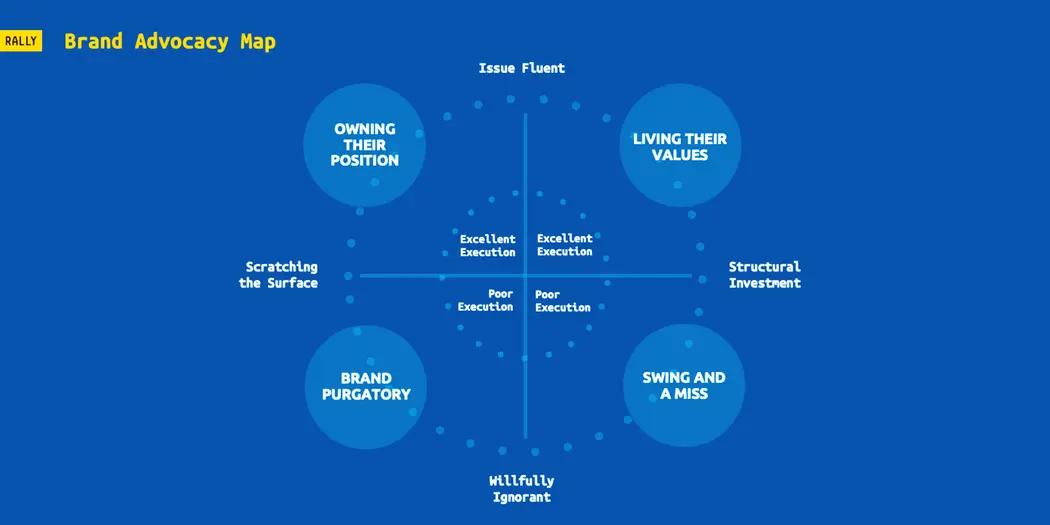Credit: Mike Ehrmann / Getty Images
In the wake of the killing of George Floyd while in police custody in May, the public relations firm Edelman surveyed more than 2,000 American consumers and found that 60% of them would either buy or boycott a brand based on its response to the moment.
“Americans want brands to step up and play a central role,” CEO Richard Edelman wrote. “Brands can no longer dodge America’s original sin and third rail: systemic racism and inequality.”
The firm found similar results for social issues more generally: 67% of consumers said they will buy from a brand for the first time because of its stance on a controversial issue; 65% of people said they will not buy from a brand that stays silent.
The question, then, is how do companies effectively step into the world of advocacy?
“Over the last few years at RALLY we’ve been watching how brands navigate this space,” said Latia Curry, a principal at the communications firm. “How do you know if a brand is doing this successfully? What does it look like? What are the key levers to getting it right?”
In a recent webinar with MIT Sloan Management Review, Curry walked through the basic answers to these questions.
Find yourself on the brand advocacy map
Curry highlighted two key dimensions in which to assess a brand’s performance. First, how deep is the company’s investment in the issue? Is the company making symbolic donations to a cause, or is it investing in structural changes internally and externally? Second, what is the company’s issue fluency with the subject? Companies can range from willfully ignorant of a social issue to deeply and authentically engaged and knowledgeable. (Curry noted that she analyzes companies based on public perception, not on a company’s self-assessment.)
With this in mind, Curry showed how you can place companies in one of four categories. Those that are both issue-fluent and committed to structural investment she described as “living their values.” Fashion line Tory Burch is one case: publicly focused on women’s empowerment, the company has backed up statements with a diverse and meaningful array of initiatives internally and externally, significant investment, and a detailed knowledge of how to affect change.
“Lots of organizations talk about women’s entrepreneurship,” Curry said. “Tory Burch has really dug into what women need to change the numbers.”
Companies that invest heavily in a cause but lack issue fluency she described as “swing and a miss.” Good intentions are necessary but not sufficient for effective brand advocacy. Similarly, companies that take a clear stance on an issue but don’t have an extensive or established record of social engagement Curry described as “owning their position.”
“They are clear on the issues, but they’re only starting to scratch the surface on how to express it,” she said. “These companies often come out around a specific moment and strike the right note.”
Sixty-seven percent of consumers said they will buy from a brand for the first time because of its stance on a controversial issue.
She placed the NBA in this category. In the wake of social unrest this summer, the NBA “supercharged efforts to fight for racial equity,” Curry said. The league painted “Black Lives Matter” on courts, sanctioned player jerseys and merchandise that spoke for the cause, and opened arenas as voting centers during the presidential election. That said, the NBA still must correct a lot of internal inequities before it is viewed as an organization that can speak with full authenticity on this issue: among 30 teams, there are only nine Black general managers, eight Black head coaches, and one Black owner.
“There is no doubt there is more we can do internally,” NBA Commissioner Adam Silver said in June.
Finally, “brand purgatory” is reserved for companies that neither make meaningful investment nor take time and energy to become issue-fluent. Attempts by these brands — the NFL, Nextdoor — to become advocates “land in a failed way,” Curry said.
The NFL’s messaging around Black Lives Matter, for instance, has “been universally panned,” according to Curry, largely because of the league’s negative response to Colin Kaepernick taking a knee in 2016. “These attempts have seemed performative,” she said.
And Nextdoor Curry described as “one of the most egregious examples” of brand purgatory. Designed as an online hub for neighborhoods, the company has become a platform that amplifies racial profiling and political conspiracy theories.
“While not there yet, Nextdoor may be remembered as the next 4Chan of social media platforms, as a place for hate,” Curry said.
Credit: RALLY
Next, go beyond the map
There is important nuance, of course, outside of these two dimensions.
As with the NBA, firms must get their own house in order if they want to become advocates. “By no means are we saying ‘Don’t act until everything is perfect inside your own organization,’” Curry said. But she suggested sharing an internal roadmap with customers. “You can say ‘We’re not there yet,’ and be open and transparent about the processes you have in place to get there.”
Leadership also must champion the idea, as it’s hard to move forward consistently and authentically if the top has not bought in. The best brand advocates also tend to move first in a space, without fear of polarizing or alienating consumers.
Finally, organizations need to accept the inevitability of missteps. The issues are complicated, Curry said; the point is not perfection, but effort. Fill your organization with people who understand the issue from different perspectives. Create space for increasing issue fluency. Have book groups and facilitated discussions. Put processes in place that shine a light on blindspots — new campaigns don’t move forward until a certain group vets them, for instance.
“There is no silver bullet for building this capacity and doing it right,” Curry said. “It’s a combination of all of these things, but it starts with commitment and a willingness to flub.”
Keep an open mind with metrics
For three years, Curry was a senior director at UNICEF, where she built corporate partnerships. In this role she learned that “high numbers do not always mean deep impact.” Vaccinating 10,000 children is an important milestone but the goal remained ending polio in India (this was ultimately a success); enrolling 20,000 girls in school is good work, but the aim is accessible education for all. Success rests on both quantitative markers of progress and the broader qualitative contexts in which you achieve these goals.
Beyond pledges and donations, Curry said organizations need to track external reputation and internal culture, decision-making processes, diversity and inclusion initiatives, employee satisfaction, and credibility around an issue.“I’m not saying this is willy-nilly cross your fingers and hope you get there, but it can’t be numbers alone that you use to measure success,” she said.




